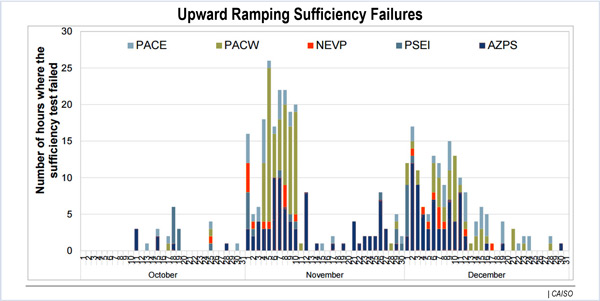By Robert Mullin
The Western Energy Imbalance Market (EIM) experienced a “dramatic uptick” in failed ramping sufficiency tests in November and December, CAISO’s internal Market Monitor reported Wednesday.
New EIM participant Arizona Public Service was especially prone to failures during the fourth quarter of last year, but other areas saw increases as well, Keith Collins, manager of market monitoring and reporting with the ISO’s Department of Market Monitoring, said during a Jan. 18 Market Performance and Planning Forum.
Some of the increase could likely be attributed to a flawed ISO calculation that underreported ramping capacity available in the market, Collins said.
But the Monitor is still trying to pinpoint the exact cause for such a significant increase in test failures over the period (see graph).
CAISO performs the sufficiency test ahead of the market run for each operating hour. The test relies on base schedules submitted by each balancing authority area (BAA) participating in the EIM.
The objective: to ensure that each BAA enters the hourly interval with enough upward and downward ramping capability to avoid leaning on the resources of other market participants, similar to the requirement that each EIM participant begin each hour fully balanced.
“When a balancing area doesn’t have sufficient ramping capacity, then there are limitations on the amount of EIM [energy] transfers that are allowed into that region,” Collins said. “For instance, if there’s an upward [ramping] limitation, [then the region’s] imports are limited.”
Similarly, the ISO will restrict exports if it finds a shortfall in a BAA’s hourly downward ramping capability.
Those restrictions are intended to discourage EIM participants from relying on the market as a way to avoid developing their own ramping capacity as growing adoption of renewable resources increases the need for such capability.
Collins noted that the flexible ramping sufficiency test “is playing an increased role in some of the market outcomes we’re seeing,” a finding that the Monitor will elaborate on in its upcoming quarterly report.
The sufficiency test is designed to determine whether each EIM participant has scheduled enough ramping capacity to meet both the expected change in “net load” within its system and the “flexible ramping constraint” at its seams.
“Net load” represents total electricity demand minus the output from variable renewable resources. The ramping constraint indicates the factor by which transmission congestion will restrict a participant’s ability to import or export during a specific interval.
Passing the Test
To pass the sufficiency test, an EIM participant must demonstrate sufficient ramping capacity from the start of an hour through each 15-minute interval of that hour. Failure for just one interval translates into failure for the entire hour. Participants can resubmit schedules up to 40 minutes before the start of the hour.
The test considers each participant’s contribution to uncertainty in EIM’s overall load forecast during an interval, as well as its net import/export capabilities. The participant receives “credit” for its ability to reduce exports or imports in order to increase upward or downward ramping capability during the period.
The EIM’s upward ramping capability exhibited the “dramatic uptick” in test failures late last year, but downward ramping capacity tests, which were just implemented in November, have also seen “a pretty consistent level of failures,” especially in the APS region, according to Collins.
Steve Keehn, associate director at Navigant Consulting, asked whether the test failures were predominantly occurring during certain hours.
“I wouldn’t point to any explicit pattern that came up,” Collins said. “We’ve seen it at the beginning of the day, the middle of the day, the end of the day.”
Justin Thompson, director of resource operations and trading at APS, sought to know why so many of the failures were occurring early in the month and diminishing by mid-month.
One possibility is that the increase coincided with the Nov. 1 implementation of CAISO’s flexible ramping product market, which operated with flawed calculations that shortchanged the amount of available ramping capacity through mid-December, according to Guillermo Bautista Alderete, the ISO’s director of market analysis and forecasting.
“That is only one part,” Bautista Alderete noted.
He said other elements of the issue would be discussed in a monthly report produced by the ISO and distributed to APS and other new EIM participant Puget Sound Energy, which would become publicly available as well.







